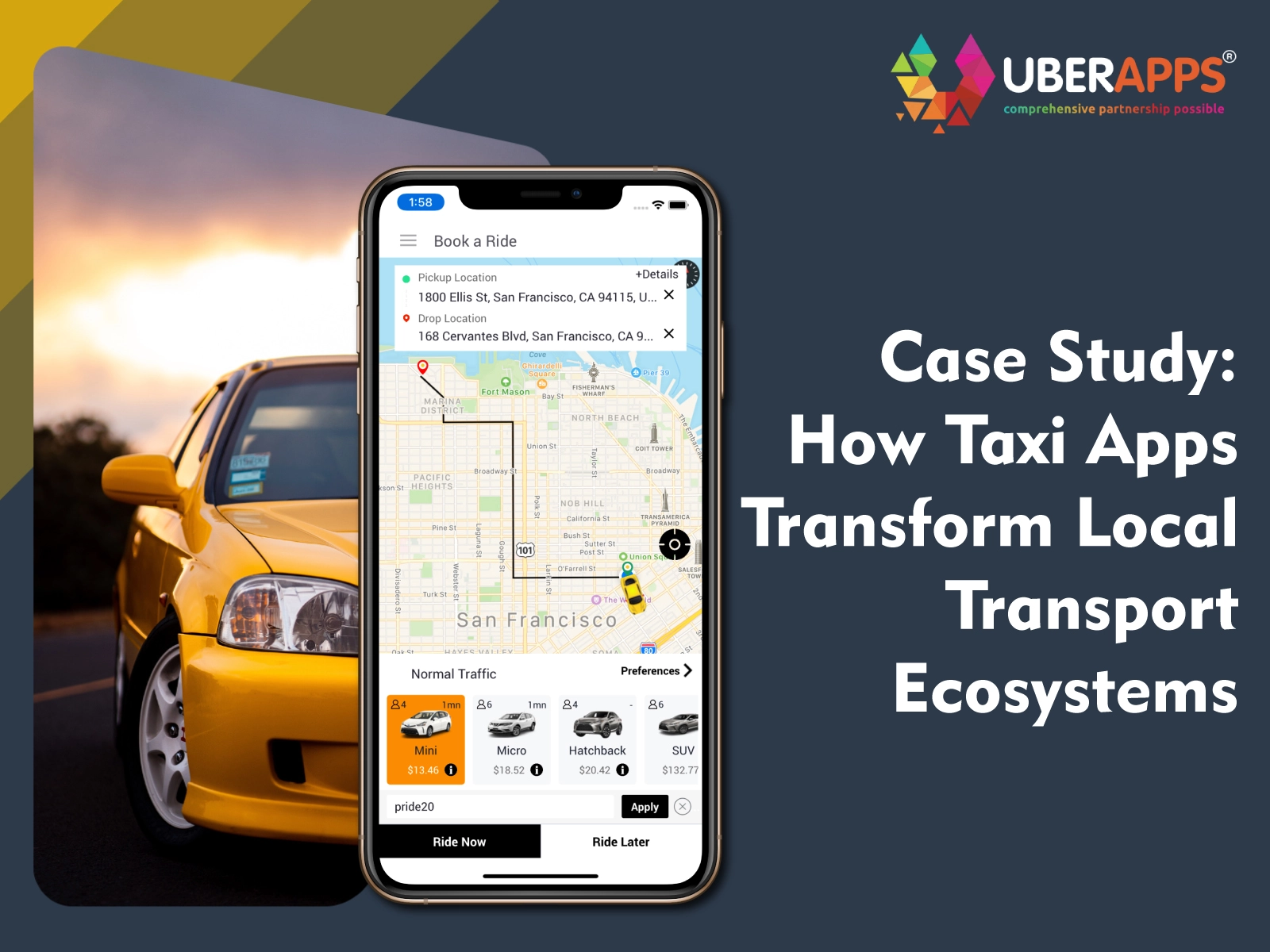
Case Study: How Taxi Apps Transform Local Transport Ecosystems
In just a decade, taxi apps have revolutionized how cities move. From congested metros to small island nations, ride-hailing platforms have brought digital transformation to local transport systems. By connecting passengers and drivers through technology, taxi booking apps have improved efficiency, safety, and accessibility reshaping the mobility landscape entirely.
This case study explores how taxi app development whether through Uber clone solutions or SaaS taxi app platforms has enabled cities and startups to modernize transport ecosystems. We’ll examine key features, real-world benefits, and measurable outcomes from local implementations.
If you’re considering launching your own ride-hailing business, this deep dive will show you how technology can turn traditional taxi services into smart, scalable, and sustainable operations.
This in-depth case study explores how taxi booking apps and SaaS taxi platforms are transforming local transport ecosystems worldwide. From improving accessibility and transparency to empowering drivers and reducing emissions, these digital solutions are redefining how cities move. Real-world examples from the Caribbean, Africa, and Europe demonstrate how even small markets can achieve big results with white-label Uber clone solutions. The blog also highlights key technologies such as AI dispatching, in-app payments, and predictive analytics that make taxi apps essential to modern mobility. It concludes by emphasizing SaaS scalability, sustainability, and human impact urging new entrepreneurs to adopt reliable taxi app development solutions for future-ready success.
The Evolution of Local Transport in the App Era
From Street Hails to Tap-to-Ride Convenience
Before the rise of ride-hailing apps, passengers relied on unreliable dispatch systems or physical taxi stands. The arrival of Uber clone platforms marked a paradigm shift—introducing digital bookings, live tracking, and in-app payments for taxi apps.
- Book rides instantly from their smartphones
- Track drivers in real time
- Pay securely using cards or wallets
- Rate trips and report issues transparently
This evolution didn’t just enhance convenience—it built trust in digital transport.
Key takeaway: Taxi apps turned mobility into a service driven by technology, not uncertainty.
The Rise of SaaS Taxi App Platforms
Traditional fleet owners once needed to invest heavily in app development. Now, SaaS taxi app models offer subscription-based access to full-featured platforms complete with admin dashboards, analytics, and payment gateways.
These white-label, cloud-powered systems let local operators launch within weeks, not months, at a fraction of the cost. Cities from Nairobi to Nassau have leveraged UberApps.tech-style SaaS solutions to build local networks that rival global players.
Key takeaway: SaaS taxi apps democratized mobility allowing any entrepreneur to build a regional transport brand.
Core Impact Areas of Taxi App Transformation
Enhancing Accessibility and Inclusivity
For commuters in remote or underserved areas, taxi booking apps provide reliable mobility where public transport is limited. Riders can access affordable trips, while local drivers gain consistent earnings through the app.
Key Benefits
- Equal access to mobility for rural and urban populations
- Custom pricing options for off-peak and high-demand zones
- Multilingual interfaces for diverse users
- Accessibility settings for differently abled passengers
Key takeaway: Ride-hailing apps close the last-mile gap, connecting every corner of the map.
Improving Safety and Transparency
Traditional taxis often lacked traceability. Today’s ride-hailing app features include:
- GPS tracking and SOS alerts
- Verified driver profiles
- Live ride monitoring
- In-app feedback and support
Passengers and regulators gain real-time visibility into every ride, while digital receipts ensure transparency.
Key takeaway: Technology transformed taxis from anonymous rides into accountable, data-driven journeys.
Boosting Economic Growth for Drivers and Fleet Owners
Empowering the Gig Economy
Taxi apps have created thousands of self-employment opportunities worldwide. Drivers earn more through optimized trip matching, bonuses, and reduced idle time.
Digital Payment Ecosystem
With in-app payments for taxi apps, drivers receive instant payouts. This shift from cash to digital reduces fraud and enhances trust.
Fleet Management Advantages
Operators use analytics dashboards to:
- Track performance and earnings
- Manage fuel efficiency
- Schedule maintenance
- Forecast demand by location and time
Key takeaway: Taxi apps don’t just move passengers—they empower livelihoods.
Case Study – How Ride-Hailing Apps Reinvented Local Mobility
Example 1 Transforming Island Transport in the Caribbean
A small island with limited public buses adopted a SaaS taxi app solution to digitize its existing cab system. Within six months:
- 70% of rides were booked online
- Local drivers earned 35% more
- Average passenger wait time dropped by 40%
With real-time tracking and digital fare calculation, the government partnered with the platform to regulate pricing and safety more effectively.
Key takeaway: Even small markets can achieve global standards with localized ride-hailing apps.
Example 2 Digitizing City Commutes in East Africa
A regional startup launched a white-label Uber clone for Nairobi, targeting middle-income commuters. Using driver training modules and referral incentives, the app onboarded 1,000+ drivers in three months.
Impact highlights:
- Driver acceptance rates rose to 92%
- Cashless transactions exceeded 80%
- The app became the city’s most downloaded mobility platform within a year
Key takeaway: Strategic localization—like mobile-money integration—fuels rapid adoption in emerging economies.
Example 3 Modernizing Airport Transfers in Europe
An established taxi cooperative in Eastern Europe transitioned to a cloud-based SaaS taxi app. Features like fare transparency, route optimization, and instant support improved rider satisfaction scores from 3.2 to 4.7 in six months.
Key takeaway: Legacy operators can evolve quickly with digital platforms and retain customer loyalty.
The Technology Driving Taxi App Innovation
Real-Time Tracking and Smart Dispatch
Modern taxi app development integrates GPS and AI-based dispatch algorithms to match riders with the nearest available drivers. These systems analyze:
- Distance and ETA
- Driver ratings
- Surge pricing zones
- Traffic congestion
Key takeaway: Smart dispatch minimizes idle time and boosts ride completion rates.
AI, Analytics, and Predictive Insights
AI-driven dashboards help operators:
- Forecast demand spikes
- Optimize driver distribution
- Predict cancellations and no-shows
- Recommend driver incentives
Key takeaway: Data analytics turns daily operations into predictable, scalable growth.
Seamless In-App Payment Integrations
Cashless payments are now essential in taxi booking apps. From cards to digital wallets, platforms integrate secure gateways to simplify fare collection.
Benefits of Digital Payments
- Instant driver payouts
- Reduced fraud and disputes
- Transparent revenue tracking
- Integration with local fintech (Paystack, Razorpay, M-Pesa, etc.)
Key takeaway: In-app payments fuel trust, convenience, and regulatory compliance.
Sustainability and Smart City Integration
Eco-Friendly Rides and Route Optimization
Taxi apps help reduce emissions by enabling route pooling and predictive dispatch. Electric vehicle (EV) integration and ride-sharing further contribute to green mobility goals.
Eco-Initiatives Powered by Tech
- EV fleet adoption with charging station maps
- Shared rides to reduce congestion
- Driver incentives for fuel-efficient driving
Key takeaway: Sustainable mobility is not a luxury—it’s the future of urban transport.
Government and Municipal Collaboration
Cities now partner with ride-hailing startups for data sharing and smart transport policies. Insights from taxi app analytics support:
- Traffic flow optimization
- Public safety initiatives
- Urban planning based on trip data
Key takeaway: Collaboration between startups and cities drives smarter, data-backed governance.
Why SaaS Taxi App Models Are the Future
Cost-Effective and Scalable
With SaaS taxi app platforms, startups can launch operations without massive upfront investment. Subscription-based access ensures predictable costs and constant updates.
Key SaaS Advantages
- Zero server maintenance
- Cloud scalability during peak demand
- Instant feature upgrades
- 24/7 technical support
Key takeaway: SaaS models make innovation accessible for every transport entrepreneur.
Speed to Market and Continuous Improvement
Unlike traditional development that can take 3–6 weeks, white-label Uber clone solutions allow launch within 2–4 weeks. With modular architecture, new features like loyalty programs or fleet analytics can be added anytime.
Key takeaway: Time saved on development is time earned for growth.
The Human Side of Taxi App Transformation
Passenger Confidence and Convenience
The seamless experience of booking, tracking, and paying through an app builds rider confidence. Transparent fares and verified drivers reduce anxiety, especially for night or solo travelers.
Empowering Local Entrepreneurs
Taxi apps allow small operators and fleet owners to build digital brands without massive capital. They can compete with global players by focusing on local service excellence.
Key takeaway: Ride-hailing technology turns local ambition into regional impact.
Challenges and Lessons Learned
Adapting to Regional Regulations
Each market has unique rules for licensing, insurance, and driver verification. Early compliance ensures sustainability.
Balancing Driver and Passenger Incentives
Over-subsidizing users can hurt margins. Instead, balance both sides through smart loyalty schemes and fair pricing.
Continuous Improvement Through Feedback
Constantly monitor feedback to refine app performance, pricing, and UX.
Key takeaway: Agility and adaptation are the lifelines of any mobility platform.
Conclusion
Taxi apps have permanently reshaped local transport ecosystems—bridging convenience, safety, and innovation. From small towns to global cities, Uber clone and SaaS taxi app models have enabled entrepreneurs to bring efficient, data-driven, and sustainable transport solutions to millions.
Through real-world examples, we see how digital platforms uplift drivers, empower commuters, and modernize traditional fleets. The shift from manual dispatch to AI-driven, real-time operations has elevated customer experience and operational excellence.
As the world moves toward smart cities, taxi booking apps will play a pivotal role in connecting communities and driving green mobility. If you’re planning to build or scale a transport business, leveraging an experienced taxi app development company like UberApps.tech can help you launch faster, operate smarter, and lead the local mobility revolution.
FAQS
1. How do taxi booking apps improve local transport systems?
Taxi booking apps streamline ride bookings, enhance safety through driver and vehicle verification, and provide transparent fare structures. This makes local commuting faster, more reliable, and safer for passengers.
2. What is a SaaS taxi app, and why is it popular?
A SaaS taxi app is a cloud-based, subscription model platform enabling entrepreneurs to launch ride-hailing services quickly without high upfront development costs. Its scalability and ease of deployment make it a popular choice for startups.
3. How do in-app payments help taxi apps grow?
In-app payments enable smooth, secure, and cashless transactions, reduce risks associated with cash handling, and help build user trust through instant receipts, refunds, and transparent transaction histories.
4. Can small towns or islands benefit from taxi app development?
Yes, localized Uber clone taxi apps have proven effective even in small towns and islands by improving local connectivity, supporting tourism, and providing convenient transport options tailored to local needs.
5. What are the essential features of modern ride-hailing apps?
Key features include GPS tracking, driver and vehicle verification, in-app chat for communication, integrated payment systems, fare estimation tools, and user feedback and rating mechanisms for service quality.
Author's Bio

Vinay Jain is the Founder of UBERApps and brings over 10 years of entrepreneurial experience. His focus revolves around software & business development and customer satisfaction.

